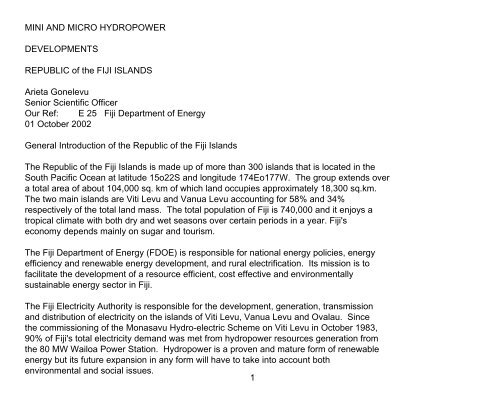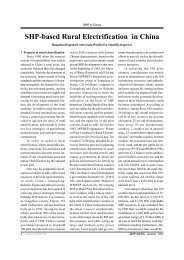FIJI - Hangzhou Regional Center(Asia-Pacific)for Small Hydro ...
FIJI - Hangzhou Regional Center(Asia-Pacific)for Small Hydro ...
FIJI - Hangzhou Regional Center(Asia-Pacific)for Small Hydro ...
You also want an ePaper? Increase the reach of your titles
YUMPU automatically turns print PDFs into web optimized ePapers that Google loves.
MINI AND MICRO HYDROPOWER <br />
<br />
DEVELOPMENTS <br />
<br />
REPUBLIC of the <strong>FIJI</strong> ISLANDS<br />
<br />
Arieta Gonelevu<br />
Senior Scientific Officer<br />
Our Ref: E 25 Fiji Department of Energy<br />
01 October 2002<br />
<br />
General Introduction of the Republic of the Fiji Islands<br />
<br />
The Republic of the Fiji Islands is made up of more than 300 islands that is located in the <br />
South <strong>Pacific</strong> Ocean at latitude 15o22S and longitude 174Eo177W. The group extends over <br />
a total area of about 104,000 sq. km of which land occupies approximately 18,300 sq.km. <br />
The two main islands are Viti Levu and Vanua Levu accounting <strong>for</strong> 58% and 34% <br />
respectively of the total land mass. The total population of Fiji is 740,000 and it enjoys a <br />
tropical climate with both dry and wet seasons over certain periods in a year. Fiji's <br />
economy depends mainly on sugar and tourism. <br />
<br />
The Fiji Department of Energy (FDOE) is responsible <strong>for</strong> national energy policies, energy <br />
efficiency and renewable energy development, and rural electrification. Its mission is to <br />
facilitate the development of a resource efficient, cost effective and environmentally <br />
sustainable energy sector in Fiji. <br />
<br />
The Fiji Electricity Authority is responsible <strong>for</strong> the development, generation, transmission <br />
and distribution of electricity on the islands of Viti Levu, Vanua Levu and Ovalau. Since <br />
the commissioning of the Monasavu <strong>Hydro</strong>-electric Scheme on Viti Levu in October 1983, <br />
90% of Fiji's total electricity demand was met from hydropower resources generation from <br />
the 80 MW Wailoa Power Station. <strong>Hydro</strong>power is a proven and mature <strong>for</strong>m of renewable <br />
energy but its future expansion in any <strong>for</strong>m will have to take into account both <br />
environmental and social issues.<br />
1
<strong>Hydro</strong>power<br />
<br />
It has always been in the interest of FDOE to promote the use of renewable energy <br />
resources and exploit these resources to provide high quality energy. For the island <br />
populations, options <strong>for</strong> electricity generation will be limited to finding local island <br />
solutions. FDOE has, over the decade, explored options <strong>for</strong> electrification of rural areas.<br />
<br />
Due to its tropical climate, Fiji is well endowed with hydropower resources <strong>for</strong> <br />
development of both large and small-scale hydropower projects. FDOE's <strong>Hydro</strong>power <br />
Assessment Programme focuses on the following objectives:<br />
To assess all potential mini/micro hydropower sites throughout Fiji and determine <br />
their feasibility<br />
To rank all potential sites within Fiji which would facilitate a more detailed <br />
examination and subsequent development<br />
Photo 1: Vatukarasa Mini <strong>Hydro</strong><br />
<br />
To ascertain the viability of the sites that have been identified and<br />
To prepare pre-feasibility study reports <strong>for</strong> viable sites.<br />
<br />
A countrywide study, undertaken by FDOE through ADB funding, identified close to 100 <br />
small-scale hydropower project potentials. These sites are now being studied by FDOE to <br />
confirm their development potential <strong>for</strong> meeting small electricity demands. Needless to <br />
say, Fiji has a significant large-scale hydropower resource potential. Fiji's next best option <br />
<strong>for</strong> hydropower development is Vaturu Water Catchment Scheme followed by <br />
Wainisavulevu/Wainikasou diversion. Significant hydropower development potential lies in <br />
Fiji's largest rivers such as Sigatoka, Ba and Navua.<br />
<br />
Based on the results of our <strong>Hydro</strong>power Assessment Programme, hydropower was <br />
incorporated into the RE policy as an electrification option. <br />
<br />
The most recent hydropower project, undertaken by FDOE, is the 30 kW Muana <br />
<strong>Hydro</strong>power Scheme that was funded by the Korean Government through the Korean <br />
2
International Cooperation Agency (KOICA), at a cost of $US200, 000. The Government of <br />
Fiji met the local costs. The project is <strong>for</strong> the electrification of three villages of <br />
Naqaravutu, Wailevu and Muana in the southern coast of Vanua Levu in the Natewa Bay. <br />
The three villages have approximately 136 households with a population of 600. The <br />
three villages also host a primary school, a health center, grocery shops, community halls, <br />
etc.<br />
<br />
Developments of Mini/Micro <strong>Hydro</strong>power<br />
<br />
<strong>Hydro</strong>power systems use the kinetic (motion) energy in flowing water to produce <br />
electricity or mechanical energy. The water flow via channel or penstock to a waterwheel <br />
or turbine where it strikes the buckets of the wheel, trans<strong>for</strong>ming the kinetic energy into <br />
mechanical energy by causing the shaft of the waterwheel or turbine to rotate. When <br />
generating electricity, an alternator or generator, which is connected to the rotating shaft, <br />
converts the mechanical power in the motion of the shaft into electrical energy. The <br />
electrical energy may be used directly, stored in batteries or converted from direct current <br />
(DC) to alternating current (AC).<br />
<br />
Mini hydropower systems generate between 100 and 1500 kW. Micro hydro systems <br />
generate up to 100 W. The power available in a flow of water<br />
Photo 1: <strong>Hydro</strong> Monitoring Equipments<br />
<br />
depends on two factors:<br />
The vertical distance the water "falls" referred to as head (measured in feet or <br />
meters)<br />
Flow rate, which is the volume of water flowing past a point in a given time <br />
(measured in cubic feet or cubic meters per second)<br />
<br />
Mini/micro hydropower electricity is an ideal energy option <strong>for</strong> the rural areas because of <br />
its low operational, maintenance and repair costs. It produces clean energy and also it is <br />
more secure and reliable when compared to other options especially <strong>for</strong> areas where <br />
transmission of grid power is difficult.<br />
<br />
3
<strong>Hydro</strong>logical data have been supplied by the PWD <strong>Hydro</strong>logy Section at locations where <br />
gauging of stream flows has been carried out in the past. However, in most instances no <br />
previous stream gauging has been undertaken and flows at time of site inspections were <br />
estimated and used in the design. Some of the sites have been examined in more detail <br />
on the ground and approximate survey checks have been made to check available heads, <br />
etc <strong>for</strong> the preliminary designs of some of the schemes.<br />
<br />
At all sites further survey will be required be<strong>for</strong>e final design work can commence and <br />
more accurate cost estimates derived. Likewise, more stream flow data should be <br />
gathered, particularly during dryer periods to assess the firm energy available at the <br />
individual sites.<br />
<br />
Environmental impact as a result of the implementation of any of these schemes would be <br />
marginal. Although the sites are relatively close to village centers, the village themselves <br />
are remote. The aqueduct and penstock routes have been chosen to avoid unstable <br />
ground and to avoid the occurrence of landslides, etc.<br />
<br />
Survey Procedure<br />
<br />
When villages request <strong>for</strong> hydro survey through the provincial office or to DOE, the survey <br />
team list the villages and undertake field survey at the potential sites. Contents of <br />
investigation are to measure the discharge at potential site and gross head <br />
Photo 3: Weir Survey ¨C Kadavu Koro<br />
<br />
between the potential site and the proposed powerhouse site ¨Cthe main purpose of this <br />
part of the investigation is to collect the data in this dossier and data collected via these <br />
surveys and investigations.<br />
<br />
Following the filed survey, all potential min/micro hydro sites in the county will be ranked <br />
to prioritize the sites <strong>for</strong> long-term hydrology (water level, rainfall, flow rate, etc.) data <br />
accumulation <strong>for</strong> the three-year monitoring period.<br />
<br />
Problems associated with small hydro development in Fiji<br />
4
The Fiji Islands generally have topographical and meteorological characteristics that <br />
present a number of problems regarding small hydroelectric developments. Most parts of <br />
the islands are subject to dry seasonal periods or dry periods between heavy rainfalls. <br />
With the generally steep topography in areas where hydro sites might be expected there is <br />
a rapid runoff and unless there is a considerable ground water feed to the stream, <br />
discharge falls off rapidly to some base flow which may be very limiting as far as firm <br />
power production is concerned.<br />
<br />
On the other hand all parts of the island are subject to occasional very high rainfalls and <br />
intensities, particularly during the passage of tropical cyclones near or over the islands, <br />
which result in very sever flooding in the streams. These floods introduce certain <br />
problems affecting the design, operation and maintenance of diversion and intake <br />
structures. Although most streams considered fro these small scale hydro electric <br />
developments convey naturally clear water during dry weather or even medium flows, <br />
during flood discharges they carry a bed load of cobbles, gravel and sand as well as <br />
floating debris which cause potential problems in small intake works. Furthermore during <br />
high rainfall periods most catchments are subject to landslips in steeper areas and this <br />
adds to debris carried down by the flood. <br />
<br />
<br />
2<br />
<br />
5






